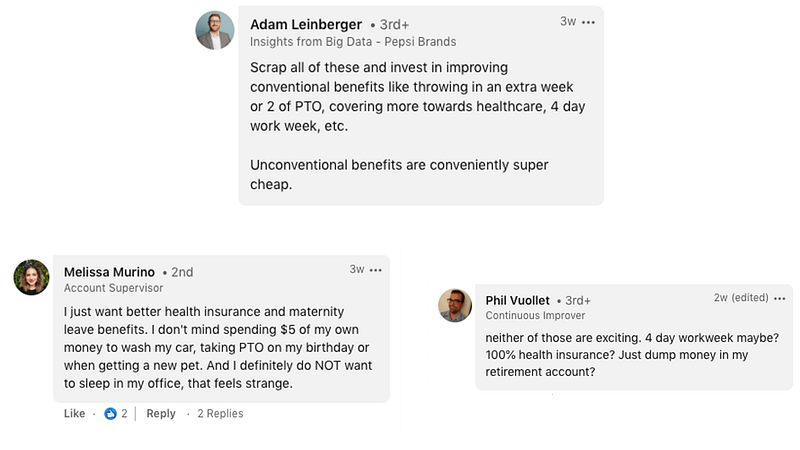Originally published 2/10/22, Updated on 9/20/22
If diversity, equity, and inclusion (DEI) initiatives are a top priority for you as an HR leader, you’re not alone.
Over the past few years, social and political turmoil have triggered much-needed conversations about the inequities that still exist in our nation and world. A rise in white supremacy, attacks on women’s healthcare, an increase in homophobia and more have left our employees vulnerable, and they’re demanding their company leaders to take action. In fact, 72% of employees want their employer to invest in creating a more diverse and inclusive workplace.
While many organizations are rising to the challenge, they still have questions. A big one for HR folks is: how do I build an inclusive benefits package that accounts for a diverse range of employee needs?
That’s one of the questions we tackled during Engage. Natalie Johnson, co-founder and Managing Director of Paradigm, led a conversation about how to combine your diversity and inclusion efforts with your employee benefits program. If you missed it, listen to the recording or check out our recap below.
How to make your most common employee benefits more inclusive
In today’s world of work, DEI is a must-have for most organizations. “Just as much as employees expect their employers to offer healthcare and PTO, they expect them to invest in DEI,” said Johnson.
But your benefits offerings and DEI initiatives shouldn’t be separate entities—they should amplify each other. This is exactly what Natalie and her team at Paradigm help their clients do. Using their DEI strategy platform, Blueprint, they conduct organizational audits to understand their clients’ benefits offerings, including how they’re deployed and utilized.
Understanding what benefits are available helps Natalie and her team identify potential gaps and areas of opportunity where employers can improve their offerings to appeal to a more diverse workforce.
Let’s start by taking a look at your core employee benefits, and explore where there might be room for improvement.
Healthcare and mental health
Most organizations offer access to health plans, and many more are starting to provide mental health benefits. However, this doesn’t necessarily mean these offerings are inclusive. If your insurance plan doesn’t cover LGBTQIA+ friendly providers, for instance, then you may be limiting options for many of your employees. Here are some questions Natalie recommends asking yourself when assessing your healthcare benefits:
- Does your healthcare policy cover in-patient and out-patient mental health care?
- Does your organization remind employees about benefits and flexibility policies at a regular cadence to encourage use?
- Does your healthcare policy cover all members of your employees’ household, including civil unions, adopted or foster children, and elderly parents?
- Does your organization have benefits that are inclusive of non-binary and/or trans employees (e.g. gender transition)?
- Does your organization provide timely reminders to employees about benefits and policies available during critical times (e.g. reminding employees about mental health benefits during a crisis)?
Parental leave and caretaking
Being inclusive with parental leave and caretaking policies starts with language. Instead of using terms like “maternity leave” and “paternity leave,” turn to more gender-neutral, non-cis conforming language like “parental leave,” “family leave,” or “gestational leave.” Ask yourself these questions as well:
- Does your organization have benefits that are inclusive of same-sex and non-biological parents (e.g. adoption benefits)?
- Does your organization have benefits that support current and future caregivers beyond what is legally required (e.g. childcare or childcare subsidies, expanded parental leave, eldercare leave, fertility support)?
- Does your organization provide managers with guidelines on how to provide access to flexible work arrangements for all employees who need them?
Working norms and physical spaces
Go beyond the “standard” benefits and think about other aspects of the employee experience, such as the design of your office and your work policies. Even a few thoughtful touches can make a huge difference to your underrepresented employees. Natalie shared questions to help you assess your working norms and physical spaces:
- Does your organization document working norms (e.g. hours, response times, availability expectations, communications)?
- Does your organization invest in tools to support remote inclusion and productivity (e.g. training, online collaboration tools)?
- Does your organization provide official guidance and/or policies on remote work?
- Does your organization provide gender-neutral/affirming restrooms?
- Does your organization accommodate lactating employees with either facilities or flexibility?
Beyond the basics: non-traditional offerings that will make your benefits package more inclusive
As a recent Jellyvision survey highlighted, we still have lots of work to do when it comes to nailing down our benefits package basics. When we asked our HR community which unconventional benefit would be most compelling to them, the responses were surprising:

At the end of the day, employees are still begging for affordable healthcare. A chance at retirement. Time off to enjoy their families.
But in today’s job market, offering just the basics isn’t enough. A comprehensive, all-inclusive benefits package is one important way to communicate to your employees that you understand and respect their broad range of needs, and are willing to go the extra mile to make sure those needs are met.
Non-Traditional Benefits Options
So here’s a (non-exhaustive!) list of non-traditional benefits that should complement your foundational offerings. These options will set you apart as an employer and drive inclusivity amongst your workforce, no matter their age, location, family situation or financial status:
- HSAs & FSAs, to help your employees save on taxes when they’re paying for healthcare
- 401K match, to reward employees for their loyalty to your company
- Flexible PTO, with a minimum number of days off per year
- Self-care days, meeting-free days, or 4-day work weeks to prevent burnout
- Generous family leave, childcare, and adoption/surrogacy assistance for new parents
- Home office allowance for employees to spend on office supplies or wifi
- Gym & wellness allowance to support a healthy lifestyle
- Lifetime learning allowance to support employees’ professional development
- Charity allowance or donation match, to support the causes that are most important to your workforce
- Employee assistance program (EAP) for mental healthcare, legal assistance, etc.
- Commuter benefits, like free parking, subsidized public transportation, and discounted gas
- Employee resource groups, to connect like-minded coworkers and build community
- Unconscious bias training, to break down barriers and educate employees on important DEI topics
- Mentorship opportunities that drive career growth within and outside of your organization
How to start prioritizing DEI at your organization
If you’re ready to start prioritizing DEI at your company, Natalie with Paradigm shared a process to help you get started.
1. Assess the inclusivity of your practice
The first step is to assess the current state of your benefits, policies, and programs. Use the questions we shared in this post as a starting point. Or, better yet, hire a company like Paradigm to help you conduct an audit of your existing benefits! Understanding where you currently are will help you get to where you want to go.
2. Use data to understand differences in employee needs and experiences
Using data can help you reveal potential problems, gaps, and opportunities when it comes to your DEI efforts. Johnson encourages companies to look at data around utilization and employee outcomes—especially across different demographics. For example, you can analyze the utilization of mental health benefits for your employees of color or the attrition rates for your working parents.
ALEX ID is here to help!
3. Listen to employees from underrepresented groups
While every employee needs to be heard, pay special attention to your underrepresented groups since they’re the most likely to be excluded from your benefits. To collect employee feedback, you can:
- Distribute an anonymous survey
- Have informal, one-on-one conversations
- Turn to your employee resource groups for insights
4. Make changes that further inclusivity, and continually assess and evolve
Finally, it’s important to recognize that DEI initiatives aren’t something you do once and check off your list. Natalie emphasized that companies need to take a consistent and iterative approach to DEI. ‘This is an ongoing process that you want to engage in. Things change and needs change, so your benefits and policies should be just as flexible and dynamic.”
Take the first step toward a more diverse, equitable, and inclusive workplace
Making the commitment to further the DEI practices of your organization isn’t easy—but it is necessary. With the right approach, you can make the workplace a safer, more supportive environment for all your employees. If you found this recap helpful, we encourage you to check out the entire conversation with Natalie and our other HR and benefits leaders.


